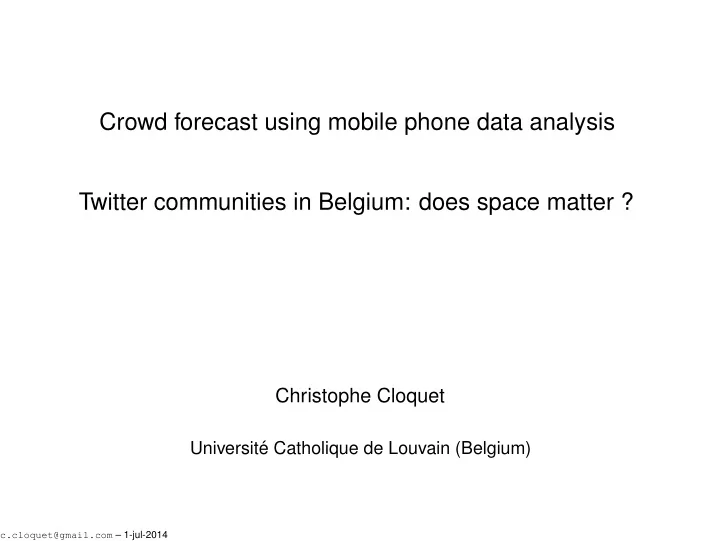

Crowd forecast using mobile phone data analysis Twitter communities in Belgium: does space matter ? Christophe Cloquet Universit´ e Catholique de Louvain (Belgium) c.cloquet@gmail.com – 1-jul-2014
c.cloquet@gmail.com – 1-jul-2014
Short term crowd forecast with mobile phone data Dataset Call Detail Records: caller and callee IDs and cells, timestamp 5 – 6 March 2014 Voice: 4 . 8 × 10 6 outgoing, 3 . 3 × 10 6 incoming Text: 19 . 9 × 10 6 outgoing, 18 . 7 × 10 6 incoming Joint work with Vincent Blondel, submitted to Big Data Research (2014). c.cloquet@gmail.com – 1-jul-2014
Measuring the fluxes of people Concentric circles with radii 2, 5 and 15 km around the venues (left) and area within which the tweets were collected (right). 2 Methods Flux(r,t) = # people approaching - # people leaving StandardDeviation(distance to event | calling to event) c.cloquet@gmail.com – 1-jul-2014
A forecasting of the zero fluxes is feasible Subscribers fluxes (C), mean distance to the event � d ( t ) � of the text messages sent to the event (F) and standard deviation σ d ( t ) (I) c.cloquet@gmail.com – 1-jul-2014
Perspectives More accurate models Use the social network Predictive calling behaviours c.cloquet@gmail.com – 1-jul-2014
Twitter communities in Belgium: does space matter ? Twitter Twitter Streaming API Geotagged tweets for Belgium ∼ 120 , 000 users ∼ 6 . 2 · 10 6 tweets nodes=users having exchanged > 3 tweets, ties=reply-to. Resulting network has 8828 nodes and 13986 edges. Work in progress joint with Vincent Blondel, Isabelle Thomas, Jean-Charles Delvenne. c.cloquet@gmail.com – 1-jul-2014
Belgium is a bilingual country where French speaking people do not tweet a lot Language attributed to the tweet by Twitter c.cloquet@gmail.com – 1-jul-2014
Community detection Modularity optimization [Newman and Girvan, 2004] N N 1 � w ij − k i k j � � � Q = δ ( c i , c j ) 2 m 2 m i = 1 j = 1 Louvain method [Blondel et al, 2008] c.cloquet@gmail.com – 1-jul-2014
Relevant scales Relax the modularity N N 1 � t w ij − k i k j � � � Q = δ ( c i , c j ) 2 m 2 m i = 1 j = 1 How to choose t ? [Delvenne et al, 2011] Swipe t . For each t : compute the communities n times See if differ: among the trials (low variation of information) among the scales Relevant scales are those for which # of communities does not change c.cloquet@gmail.com – 1-jul-2014
Four relevant scales for the reply-to network c.cloquet@gmail.com – 1-jul-2014
A cities network besides the language-based networks t=35 c.cloquet@gmail.com – 1-jul-2014
Flanders is structured around two poles t=20 c.cloquet@gmail.com – 1-jul-2014
West-Flanders is structured around three cities t=3.5 c.cloquet@gmail.com – 1-jul-2014
Perspectives Improve the network construction Address the drawbacks of modularity [Lancichinetti and Fortunato, 2011; Good et al, 2010; Lee and Cunningham, 2014, . . . ] Statistical significance ? Overlapping communities ? Local optimization ? . . . By comparing with other techniques (eg: OSLOM [Lancichinetti et al, 2011, ] ) c.cloquet@gmail.com – 1-jul-2014
Conclusions Mobile phone data help to forecast the crowds Twitter communities in Belgium transcend linguistic communities. c.cloquet@gmail.com – 1-jul-2014
Thank you Christophe Cloquet Universit´ e Catholique de Louvain (UCLouvain) – Belgium post-doc until yesterday christophe.cloquet@uclouvain.be → c.cloquet@gmail.com @ibrux – linkedin.com/ccloquet Joint works with Vincent Blondel (on crowd & twitter), Isabelle Thomas (on twitter) and Jean-Charles Delvenne (on twitter). c.cloquet@gmail.com – 1-jul-2014
Recommend
More recommend